By Jeffrey A. Rendall, Photos By Jeffrey A. Rendall
OCHO RIOS, JAMAICA – Every golf experience is different, but some are more different than others. Such was the case at Sandals Golf & Country Club in Ocho Rios, Jamaica.
It’s much apart from what you’d see in the United States, that is – and its distinctiveness was part of its charm.
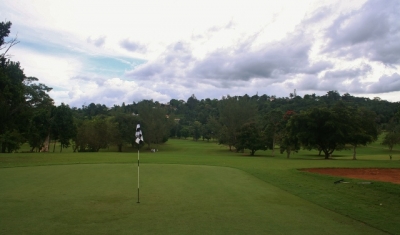 |
| Looking back from the first green. |
Ocho Rios is located on Jamaica’s northern shore, and is home to some of the island’s posh beach resorts and notorious tourist attractions, such as Dunn’s River Falls and Dolphin Cove, where you can literally swim with the dolphins. The city and golf club are accessible any number of ways, but we took advantage of the chance to visit Sandals during a one-day shore excursion while on a Princess Caribbean cruise (guests at Sandals resorts can play the course – greens fees are included in their stay).
Unlike what you’d expect from a golf course at a beach destination, the club isn’t located on the sand, or even near the ocean. You’ll take a bus or a taxi into the hills, passing through some local neighborhoods – which provides some pretty scenery as well as a quick look into the depressed economic condition of the country, and why it’s so dependent on tourism and foreign cash to feed its financial system.
And because Jamaica was once a British colony, the traffic still drives on the left side of the road. Our tour guide also advised us to look to the sides of the bus while en route – to not only take in the local sights, but also as a warning -- glancing forward at oncoming Jamaican drivers can sometimes be a frightening proposition.
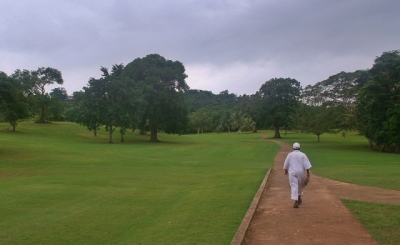 |
| Most of the tee shots are pretty straight-forward on the Sandals course, but here on the 16th tee you'd better take your caddy's advice, and avoid going left. |
At first glimpse, Sandals Club didn’t appear a whole lot different than what you’d see at a tropical resort destination with some elevation to it. There’s an attractive clubhouse overlooking a nicely laid out golf course, lots of green foliage and some palm trees. But as your tee time approaches, you’re introduced to your Jamaican caddy, and it’s like a whole new world on the golf course (more on the caddies below).
Sandals Club’s Head Golf Professional, Ewan Peebles, takes the story from here. “Upton Golf Club, as our club was originally known, opened in 1951 as a 9-hole course (designed by P.K. Saunders) located over 700 feet above sea level, in the town of Upton, a few miles east of the resort town of Ocho Rios. The layout was expanded to eighteen holes in the early 1960’s.”
Peebles continues, “The clubhouse was relocated several times before settling in its existing location. Sandals Resorts International purchased Upton Golf Club in 1992, and set upon creating the most elite golf course in Jamaica. The course conditions had deteriorated up to that time, so the greens were rebuilt with Tifdwarf Bermuda grass and the fairways resurfaced with common Bermuda grass.”
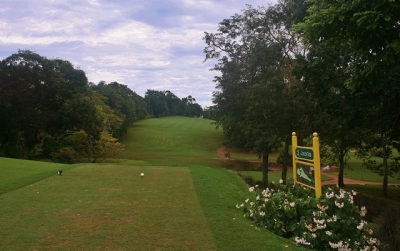 |
| It's a good thing you don't need to hit driver very often at Sandals, because if you're not hitting straight, you'll usually be in some trouble. |
I can’t speak to whether Sandals Club is the most elite golf course in Jamaica, but for what it’s worth, Golf Digest gave it a four-star rating.
Upton Club was originally established during the last years of British colonization of Jamaica, and Peebles said that during the low season, Upton’s owner, Mr. Collier -- would close down what is now the 6th hole and use it to host Polo matches.
No polo these days, but there’s still plenty of relaxing golf played at Sandals. Peebles says the club is renowned for its atmosphere as well as its picturesque views, rich surrounding vegetation and friendly staff. In addition, the course is relatively short (6311 yards from the back tees) and tight – but can be played by all skill levels without too much aggravation.
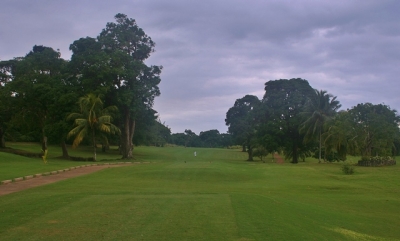 |
| As the photos indicate, it'd gotten gloomy by the time we reached the 12th tee -- and then we had to face the toughest tee shot on the course. |
We played there during the ‘high season,’ running from mid-December to the end of April – which corresponds nicely with the ebb and flow of cold weather up north. Our Jamaican caddy said it never gets cold (he didn’t even know what it would be like to be really cold), and during the summer, it gets very hot and humid.
Needless to say, the club stays open 365 days a year.
The day we played was warm and very humid (at the end of December), and was overcast with the threat of rain (it’d rained the previous days and the course was very wet). Apparently Sandals Club is set in a rainy part of the island, so expect some clouds on your visit (the sunniest areas are on the west side of Jamaica).
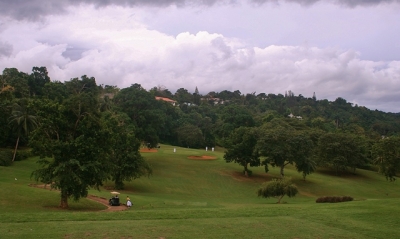 |
| Though the par three fourth hole only measures 174 yards, the size of the target (in the distance) makes it seem a lot longer. |
Peebles describes the playing aspects of the Sandals Club: “At first glance, people see the course is pretty short and would appear to play fairly easy. But the small elevated greens provide a stern test for even the most skilled golfers, without intimidating the more novice players.”
“The challenging part of playing the course is in its elevation changes, in addition to the small greens and the gentle Caribbean breeze,” Peebles added. “The fairways are gently undulating, resulting in the golfer rarely getting a perfectly flat lie and stance. Because of the size of the elevated greens, even short approach shots must be played with care and precision.”
“Finally, at over 700 feet above sea level, the wind is almost always a factor, at times forcing players to take two to three clubs more than usual,” Peebles concluded.
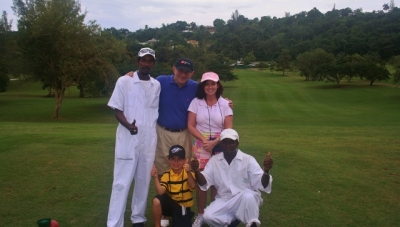 |
| You'll remember the golf in Jamaica, but you'll also remember your playing partners and caddies. Here, from left, 'Fish,' Terry Michaels, Ellie Malmin, and kneeling, Ford Malmin and our caddy, 'Cowboy.' |
One unique aspect of the layout that wasn’t immediately apparent was the routing – it runs circularly in a clockwise direction, so every hole on the course lies adjacent to another on its right-hand side. Slicer’s paradise! At the same time, many of the holes have out of bounds on the left, so anyone with a hook can expect some problems.
Continuing that thought – the caddies were exceptional in finding wayward shots. They knew every inch of the course, and when we’d hit it sideways (mostly me), they’d find it – sometimes even in thick vegetation. These guys earn their pay.
Hole highlights include the third hole, a 359-yard par four. The fairway is bordered by trees on both sides, and from the back tees, it looks like there’s a sizeable carry to reach the fairway (Peebles says it’s a 200 yard carry). There’s out-of-bounds on the left as well. Once there, you’re not done – a small, well bunkered green will test your approach-shot skills with a wedge.
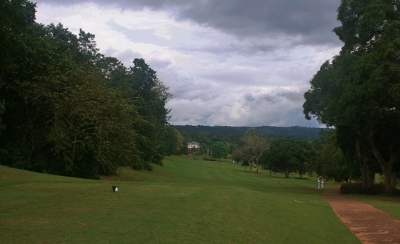 |
| The fifth hole slopes from left to right, and is typical of the need to work the hillsides on the Sandals course. |
The next hole (par three fourth) is one of the most picturesque on the course, where you’ll tee off from the highest point on the property to a green that appears a lot farther away than it is (174 yards). It might look like the hole is longer because the green is absolutely tiny. A swirling breeze will play tricks with your club selection, and the putting surface (what there is of it) is severely sloped.
Moving to the back nine, the 442-yard, par four twelfth is the longest two-shotter at Sandals, and is probably its toughest hole. Out-of-bounds runs the length of the hole on the left and there are two large mango trees along the right side of the landing area – making it the most challenging tee shot as well.
The longest par four is followed by the course’s shortest par three, which measures ‘only’ 148 yards. Short can be deceiving, as Peebles points out the green is elevated and only twelve yards deep – and there’s a prevalent, swirling breeze making correct club selection vital.
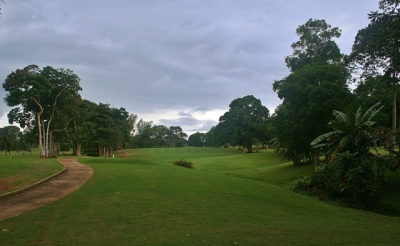 |
| The view from the 8th tee. |
As pleasant as playing the golf course was, the Sandals caddies ‘make’ the experience. All golf courses in Jamaica have a caddy program, and most of the participants are given generous opportunities to learn and play the game. They’re trained by the professional staff at each club, and are well schooled in the yardages and can ‘club’ you as good as any caddies we’ve ever had.
Our caddy called himself ‘Cowboy,’ and while the golf trip around the layout was certainly enjoyable, it was conversing with Cowboy and his lessons on Jamaica that made the day especially memorable. Cowboy was in his mid-forties, is a single-digit handicap, and said the caddy corps can play the course in the evenings and during the low season to hone their craft.
Many of them grow to be accomplished players – and based on their demonstrations of how to play some short wedge shots, their earlier low handicap revelations proved more than a mere boast.
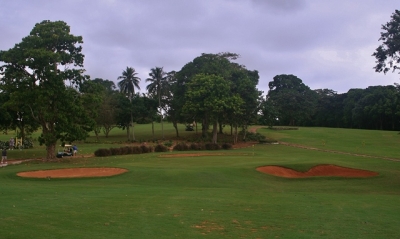 |
| Looking towards the 8th green -- bunkers and a small target demand accuracy. |
Cowboy said he’d never been off the island, and one day hoped to travel to the United States. It helps put the world in perspective (and how lucky we Americans are), as most of the population of Jamaica had never ventured beyond the confines of their own island – and some had probably never seen all of their own country, either. According to Cowboy, caddying is a pretty well paying vocation, and he felt fortunate to have the opportunity.
Cowboy explained that the agricultural sector of Jamaica is diminishing, due mostly to a lack of interest in hard work amongst the country’s youth. Simply put – farming is tough, especially in that climate. Tourism and services now accounts for about 70% of the island’s gross domestic product, and the prospects for the country’s young people are severely limited.
Cowboy and the other caddy for our group, ‘Fish,’ took their duties seriously, but also showed us a good time. In other words, they did their job well, with the sense of humor that’s characteristic of Jamaicans in general. With our few hours out on the golf course, it was more than just golf – it was a chance to learn about an interesting people and the country they inhabit.
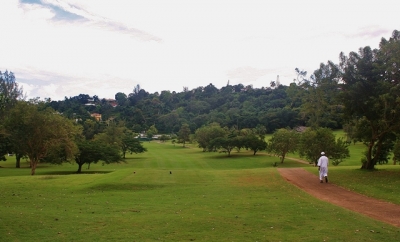 |
| Heading for home on the 18th tee. You'll hardly believe it's over, but playing in Jamaica is something you'll never forget. |
The caddies, the golf and the relaxing atmosphere are all part of the experience at Sandals Golf & Country Club. The staff is very service oriented, and your money’s well spent, especially on the tips for your caddy. You’ll remember the golf shots, but you’ll remember the ‘lessons’ even more.
Details:
Sandals Golf & Country Club
Website: http://www.sandals.com/general/golf.cfm
Information and booking: 1-888-SANDALS
Tees/Yardage/Slope/Rating
Blue 6311 128/70.9
White N/A 125/69.9
Red N/A 120/69.3
Rates:
Greens fees vary, depending on which property you’re staying at. Optional cart rental is $40; mandatory caddy fee: $17; club rental: from $30; shoe rental: $16.
Caddies are not Sandals employees, so tips are acceptable.
You may walk the course at any time, with a caddy.
| Related Links | Comments on this article? | |
|
Maryland National Golf Club Hollow Creek Golf Club Rocky Gap Resort PB Dye Golf Club in Ijamsville Whiskey Creek Golf Club |
E-mail Jeff Rendall, Editor: jrendall@golftheunitedstates.com |












